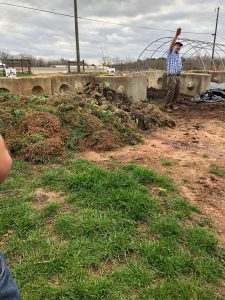1. For my final project, I went to Clarke Central High School to help AP Bio students learn about antibiotic resistance.
2. In order to prepare for this field trip, the entire class went through our own walkthrough of the same experiment the high school students would be conducting. We collected our own samples of dirt from different areas on campus, logged the exact latitude and longitude of our samples, and then brought them into class in order to dilute them to the point where we could count the levels of bacteria. We then plated the bacteria, adding different amounts of antibiotic to the plates. By the end, we had three different plate sets: those treated with no antibiotics, those with Tet3 antibiotic (which was the weaker of the two antibiotics), and Tet30 (the stronger antibiotic). Each set had plates with staggered levels of diluted soil, ranging from 10 to 10,000.
After the plates had incubated, we counted the colonies of bacteria. Since the levels of dilution varied, some plates were swarmed in bacteria, while some had little to none. We were told that the optimal bacteria levels for counting were between 30 and 300, so we used the plate with levels between that amount and multiplied it by the dilution factor in order to get an estimate of how much bacteria was in the real-world soil sample.
3. This project was interesting because it had a very hands-on approach. By conducting every step, I felt engaged in the experiment and it was easier to understand how each step in the process worked, whether it was the dilutions or the antibiotics or anything else. I learned that, scarily, there is a lot of bacteria in our nearby environment that is resistant to antibiotics. I also found that working on the subject matter a second time, while presenting and helping the high school students with their own experiment, made the information stick in my head. Articulating the process in my own words to the students made me really think about what it meant and how antibiotic resistance works.
4. We incorporated the following characteristics by relating the experiment to the high schoolers’ individual lives. Everybody, at one point or another, plays outside or even walks on a dirt path. But nobody really stops and thinks about how the bacteria in the soil exists and how it is getting stronger and more resistant to common antibiotics. By highlighting a global health concern, and then relating it back to their lives, it creates a relevancy for the audience. By thinking about how the problem occurs and taking necessary scientific steps to visualize it, we stimulate the students intellectually. Lastly, the experiment itself was creative because it wasn’t an ordinary classroom exercise–instead, we were actively conducting research and experimenting.
5. As an education major, it was nice to get into a classroom and try out skills that I will eventually be using in the future. I definitely felt more confident, and I felt surprisingly comfortable talking about the subject even though science is not my strong suit and I don’t want to become a science teacher. It made a huge difference that I knew the material well and felt comfortable talking about it in my own words, and I think that I would not have felt as comfortable if we didn’t perform our own similar experiment beforehand. I don’t think I had any assumptions about the audience, but I was surprised to see the quality of educational materials at Clarke Central–every student had a Chromebook readily available.
6. Going in, I figured that the students didn’t know much about the experimental process, so I tried to explain it as simply as possible. For me, that was easy, because in order for biology to make sense in my head it has to be in layman’s terms. This made it simple because the terminology that I remembered wasn’t confusing for the students. In future communication efforts, I can execute this similarly in order to get my point across without confusing the audience.
7 I would have tried to create a dialogue with the students in order to get a better understanding of how much they knew about the topic or experiment itself, so we could cover more ground without being repetitive.
8. This experience helped me understand the material relating to antibiotic resistance because it gave me tangible objects to associate with the unit terminology. By analyzing my audience, I was able to get a general feel for how well the students grasped the material, so that I could explain what they didn’t know. As the experiment went on, it got more complex, and it was important that the students understood the initial procedure so that they could extract data from their results. Feedback from the students was important, because it allowed me to further understand their limits on what they knew and what I needed to explain to them.
9. Again, as a future teacher (hopefully), this classroom experiment will help me by giving me real experience in a school with a core subject matter. Especially because I don’t plan on teaching a STEM subject, it gave some light on how being a STEM teacher works and how it is different from, say, a history teacher.
10. I think that I came across the way I hoped to come across. I think that I offered myself to the class as a resource to help with the assignment without doing it for them, and when needed, could explain the process in a way that made sense. In the future, I hope that I can improve my communication skills even further.
11. While the assignment that I completed was different from that described in the question, I still feel that this assignment was effective in helping me learn the about antibiotic resistance while also getting to help in the local Athens community.



